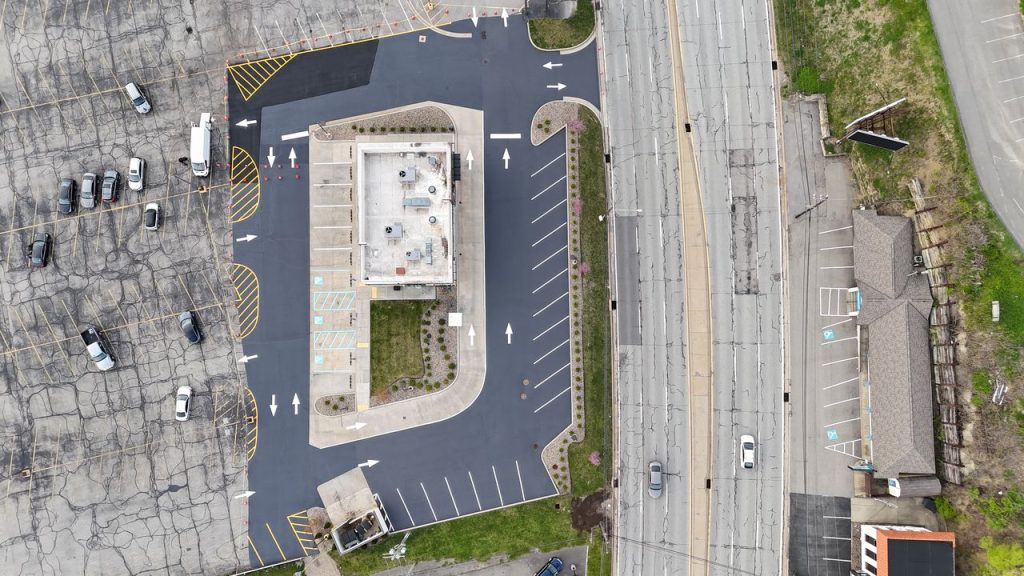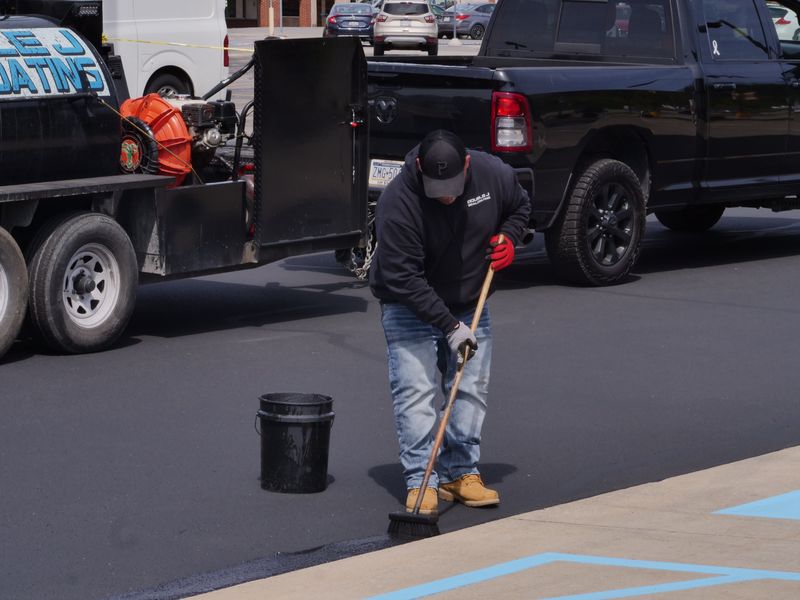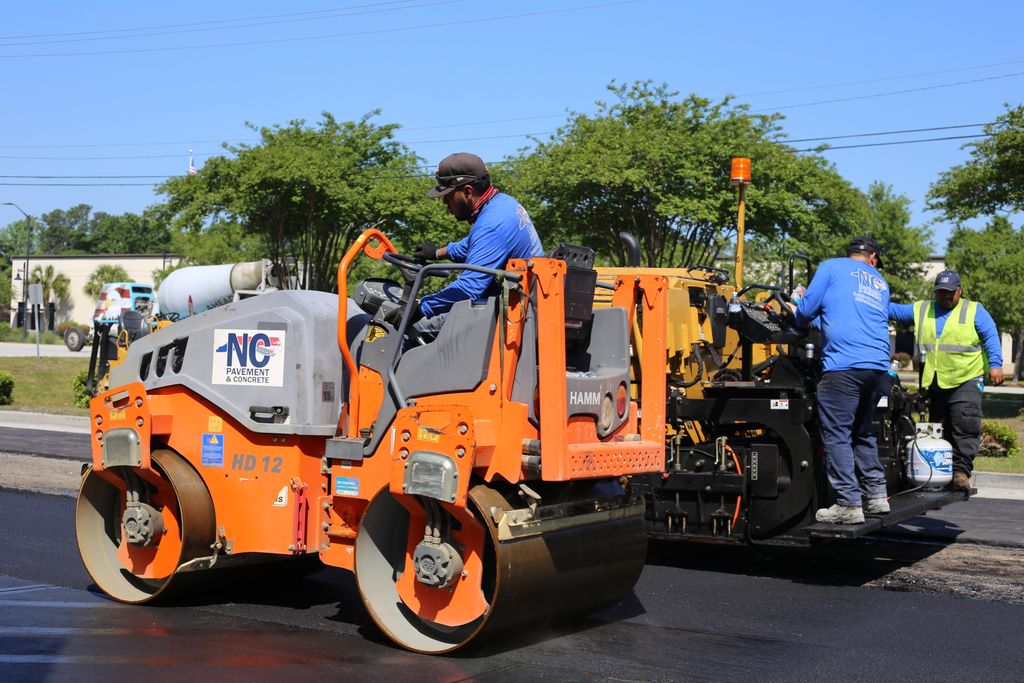You ever drive into a business and before you even walk inside you notice the parking lot is rough? Not just a couple of cracks but those deep, ankle-twisting potholes that make you think twice about even parking. Here’s the thing. That first impression could be costing that business more than they realize. Pavement isn’t just pavement. The decision between an asphalt overlay and a full paving job can literally change the way people see your property and how much you spend over the next decade. If you own commercial property in the Pittsburgh area, you know our winters, freeze-thaw cycles, and constant traffic can chew up asphalt fast. So let’s break down what makes the most sense for your bottom line.
Why the Decision Matters More Than You Think
Asphalt maintenance isn’t just about filling cracks or throwing down a patch. Choosing the wrong resurfacing method could mean you’re repeating the same project years too soon. And in business, every unnecessary dollar spent is a dollar that could’ve gone toward growth, equipment, or staffing. At The Pavement Group, we’ve worked on everything from small retail plazas in Cranberry Township to sprawling industrial lots in South Fayette, and the cost difference between overlay and full paving over time can surprise you.
What is an Asphalt Overlay?
An asphalt overlay is like putting a fresh layer of skin on your pavement. We apply a new layer of asphalt (typically 1.5 to 2 inches thick) directly over the existing surface. It’s faster, less disruptive, and generally cheaper than tearing everything out. But here’s the catch, overlays only work when your existing pavement base is still solid. If your parking lot has major foundation problems or deep cracks caused by base failure, an overlay is just a temporary bandage.
What is Full Paving?
Full paving, sometimes called full-depth reconstruction, is starting from scratch. We remove the old asphalt entirely, repair or replace the base, and then lay brand-new asphalt from the ground up. It’s the heavy-duty fix. It costs more upfront, but it addresses deep structural issues that overlays can’t solve. If your property in places like Robinson Township or Monroeville gets heavy truck traffic or has drainage problems, full paving might be your only long-term option.
Cost Comparison: Asphalt Overlay vs. Full Paving
Upfront Cost
- Asphalt Overlay: Typically 30–50% cheaper than full paving. Less labor, fewer materials, and shorter downtime.
- Full Paving: Higher cost due to complete excavation, base work, and more asphalt.
Lifespan
- Asphalt Overlay: Average lifespan is 8–12 years when properly maintained.
- Full Paving: Can last 20–30 years with regular sealcoating and maintenance.
Business Downtime
- Asphalt Overlay: Often completed in 1–2 days depending on size.
- Full Paving: Can take 3–7 days or more, especially for large commercial lots.
When Asphalt Overlay Makes Sense
Overlays are ideal when:
- The base is structurally sound
- Cracks are mostly surface-level
- There’s no significant water drainage issue
- Budget is limited but you still want to improve curb appeal quickly
Example: We recently completed an overlay for a bakery in Mount Lebanon. Their lot looked tired, but the base was strong. We wrapped the job in two days, and their sales actually went up because customers weren’t dodging potholes anymore.
When Full Paving is Worth the Investment
Full paving is the right choice when:
- Base failure is visible (deep alligator cracks, uneven surfaces)
- Water pooling is a problem
- Heavy commercial or industrial traffic wears down surfaces quickly
- You plan to own or lease the property long-term
Example: A distribution center in McKees Rocks had delivery trucks tearing up the lot every week. An overlay would have been destroyed within a couple of years. We rebuilt the lot from the base up, and five years later, it’s still holding strong.
Local Conditions That Affect Your Decision
Pittsburgh’s climate plays a huge role. Our freeze-thaw cycles expand and contract pavement repeatedly. If your base is already compromised, winter will find that weakness fast. In neighborhoods like Bethel Park and Ross Township where plowing is frequent, thin overlays can wear down faster. That’s why local expertise matters. We know the patterns of wear unique to Western Pennsylvania.
Testimonial: Homeowner Experience
“We live just outside of Wexford and our driveway was a disaster. I honestly thought we’d have to rip it all out, but The Pavement Group inspected it and said an overlay would work perfectly. They were right. It’s been three years, it still looks brand new, and the crew was so professional I actually enjoyed having them around. We saved thousands and avoided a huge mess.” — Sarah L., Wexford, PA
Pros and Cons at a Glance
Asphalt Overlay
Pros: Lower cost, faster installation, minimal disruption
Cons: Won’t fix deep structural issues, shorter lifespan
Full Paving
Pros: Long lifespan, fixes all base problems, better for heavy traffic
Cons: Higher upfront cost, longer downtime
The Pavement Group’s Recommendation Process
We don’t just look at the surface. Our team examines your pavement’s foundation, drainage patterns, and traffic usage. We give you the real numbers, so you can see what you’ll spend now versus what you’ll save later. That’s why our clients in places like Fox Chapel and Bridgeville trust us. We treat their property like our own.
Invest in Your Business’s Success.
Your pavement is the red carpet to your business. If it’s worn out, customers notice. Don’t waste money on the wrong fix. Contact The Pavement Group today for a free on-site evaluation anywhere in the Pittsburgh region. We’ll tell you straight whether you need an overlay or a full paving job and back it with work that lasts. Call us now and let’s get your pavement ready to impress.
Frequently Asked Questions
1. What is the main difference between asphalt overlay and full paving?
An asphalt overlay adds a new layer over existing pavement while full paving replaces the entire surface and base. Overlays are faster and cheaper but only work if the base is solid. Full paving is more expensive but fixes deep structural issues.
2. How long does an asphalt overlay last in Pittsburgh?
Most overlays last 8–12 years with proper maintenance. Pittsburgh’s freeze-thaw cycles can shorten that if the base isn’t strong. Sealcoating and regular inspections help maximize lifespan.
3. When should I choose full paving over an overlay?
Choose full paving when you see deep cracks, base movement, or drainage issues. It’s also best for heavy truck traffic areas. Long-term owners often choose full paving for its durability.
4. Is an asphalt overlay cheaper than full paving?
Yes, overlays are typically 30–50% less expensive upfront. However, you must factor in future repairs since overlays have a shorter lifespan. Full paving can be more cost-effective over decades.
5. Can I overlay old, damaged asphalt?
You can if the damage is only surface-level and the base is stable. If the base is failing, overlaying will only hide problems temporarily. A professional inspection is critical.
6. Does Pittsburgh’s weather affect my decision?
Absolutely. The freeze-thaw cycles here can quickly damage pavement with a weak base. Our local climate makes base stability a key factor in choosing between overlay and full paving.
7. How long will my business be closed for paving work?
Overlays can often be completed in 1–2 days. Full paving can take 3–7 days or more depending on lot size and weather. Planning around your business schedule is essential.
8. What maintenance does asphalt need after installation?
Both overlays and full paving need regular sealcoating, crack sealing, and occasional patching. Staying ahead of small issues keeps the surface in good shape longer.
9. Can The Pavement Group work on large commercial lots?
Yes, we handle everything from small driveways to massive distribution centers. We have the equipment and crew to manage large projects efficiently.
10. How do I get an estimate from The Pavement Group?
Simply call or fill out our online form. We’ll schedule a free on-site evaluation, explain your options, and provide a detailed written estimate.


